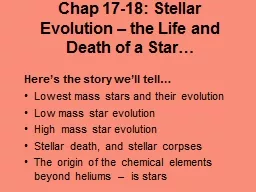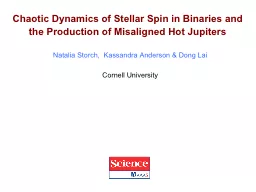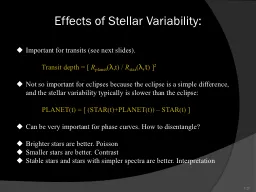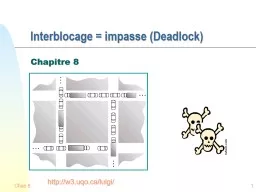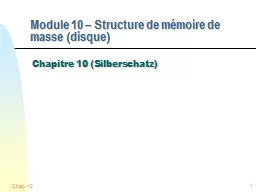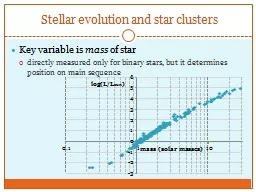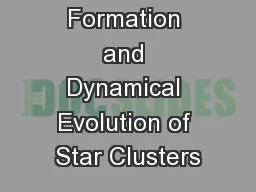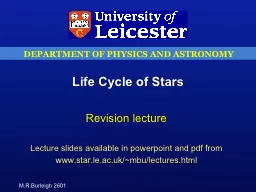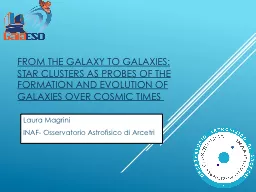PPT-Chap 17-18: Stellar Evolution – the Life and Death of a Star…
Author : phoebe-click | Published Date : 2019-10-30
Chap 1718 Stellar Evolution the Life and Death of a Star Heres the story well tell Lowest mass stars and their evolution Low mass star evolution High mass star
Presentation Embed Code
Download Presentation
Download Presentation The PPT/PDF document "Chap 17-18: Stellar Evolution – the L..." is the property of its rightful owner. Permission is granted to download and print the materials on this website for personal, non-commercial use only, and to display it on your personal computer provided you do not modify the materials and that you retain all copyright notices contained in the materials. By downloading content from our website, you accept the terms of this agreement.
Chap 17-18: Stellar Evolution – the Life and Death of a Star…: Transcript
Chap 1718 Stellar Evolution the Life and Death of a Star Heres the story well tell Lowest mass stars and their evolution Low mass star evolution High mass star evolution Stellar death and stellar corpses. Galaxies. T.Naab. , P. Johansson, R. . Cen. , K. . Nagamine. , R. . Joung. . and J.P.O.. PPPL:, 19 Dec . 2012. ApJ.L.,. 658,710 . (2007) ApJ.,697, . 38 . (2009). ApJ.L.,699,L178 (. 2009. ). ApJ.,725,2312 . . Natalia Storch, Kassandra Anderson & Dong Lai. Cornell University. Many hot Jupiter systems . have . been found to exhibit misalignment between the . orbital axis (. L. , the axis perpendicular to the orbital plane) . 1. /28. Important for transits (see next slides).. . Transit depth = [ . R. planet. (. λ. ,t. ) / . R. star. (. λ,t. ) ]. 2. Not so important for eclipses because the eclipse is a simple difference, and the stellar variability typically is slower than the eclipse: . 1. Interblocage = impasse (Deadlock). Chapitre 8. http://w3.uqo.ca/luigi/. Chap 8. 2. Interblocages: concepts importants. Caractérisation: les 4 conditions. Graphes allocation ressources. Séquences de terminaison. 1. Module 10 – Structure de mémoire de masse (disque). Chapitre . 10 (. Silberschatz. ). Chap. 10. 2. Concepts importants du Module 10. Fonctionnement et structure des unités disque. Calcul du temps d’exécution d’une séquence d’opérations. Interpolating Values. Animation(U), Chap 3, Interpolating Values. 1. 2. Outline. Interpolating/approximating curves. Controlling the motion of a point along a curve. Interpolation of orientation. Working with paths. Key variable is . mass. of star. directly measured only for binary stars, but it determines position on main sequence. Cluster ages. Main-sequence luminosity increases . much. faster than mass. therefore massive stars use up their fuel much faster. Wen-Ping . Chen . National . Central . University . Census of Galactic open clusters. . Dynamical evolution of a star cluster. . Star clusters as targets and as tools. Outstanding issues. 2017 April 28 PMO . Revision . lecture. Lecture slides available in . powerpoint. and . pdf. from. www.star.le.ac.uk. /~. mbu. /. lectures.html. Everything taught in the course is examinable…... However, here is a crib sheet of what to focus on. Chap 5-. 1. Chapter 5. Discrete Probability Distributions. Basic Business Statistics. 12. th. Edition. Chap 5-. 2. Copyright ©2012 Pearson Education, Inc. publishing as Prentice Hall. Chap 5-. 2. Learning Objectives. Chap 16-. 1. Chapter 16. Time-Series Forecasting. Basic Business Statistics. 12. th. Edition. Chap 16-. 2. Copyright ©2012 Pearson Education, Inc. publishing as Prentice Hall. Chap 16-. 2. Learning Objectives. FALL . 2018. 2018. Chap. 12 -- Privileges. 2. DEFINITION. A PRIVILEGE IS A RIGHT OF SOME PERSON OR ENTITY TO BLOCK THE ADMISSION OF CERTAIN KINDS OF EVIDENCE IN A CASE. EVEN THOUGH RELEVANT. EVEN THOUGH CRUCIAL. Prof. JANICKE. 2018. Evid. Intro. Chap. 1. THE SUBJECT IS:. A BODY OF RULES, TELLING LAWYERS WHAT THEY CAN AND CAN’T (MOSTLY) DO TO . ESTABLISH FACTS. AT TRIAL. “LAW” POINTS ARE ESTABLISHED DIFFERENTLY; NO RULES OF EVIDENCE APPLY. Laura . Magrini. INAF- . Osservatorio. . Astrofisico. di . Arcetri. In Our Galaxy. Open clusters (disc population): . Many (~2200 known clusters). . even more new candidates in the inner disc from infrared surveys .
Download Document
Here is the link to download the presentation.
"Chap 17-18: Stellar Evolution – the Life and Death of a Star…"The content belongs to its owner. You may download and print it for personal use, without modification, and keep all copyright notices. By downloading, you agree to these terms.
Related Documents

